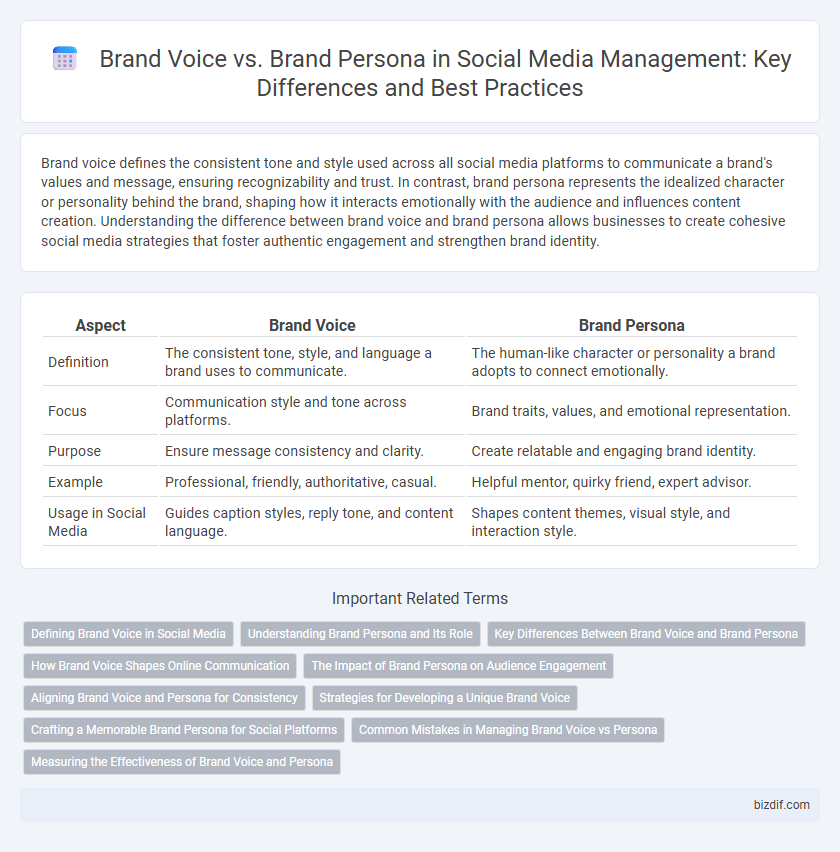Brand voice defines the consistent tone and style used across all social media platforms to communicate a brand's values and message, ensuring recognizability and trust. In contrast, brand persona represents the idealized character or personality behind the brand, shaping how it interacts emotionally with the audience and influences content creation. Understanding the difference between brand voice and brand persona allows businesses to create cohesive social media strategies that foster authentic engagement and strengthen brand identity.
Table of Comparison
| Aspect | Brand Voice | Brand Persona |
|---|---|---|
| Definition | The consistent tone, style, and language a brand uses to communicate. | The human-like character or personality a brand adopts to connect emotionally. |
| Focus | Communication style and tone across platforms. | Brand traits, values, and emotional representation. |
| Purpose | Ensure message consistency and clarity. | Create relatable and engaging brand identity. |
| Example | Professional, friendly, authoritative, casual. | Helpful mentor, quirky friend, expert advisor. |
| Usage in Social Media | Guides caption styles, reply tone, and content language. | Shapes content themes, visual style, and interaction style. |
Defining Brand Voice in Social Media
Defining brand voice in social media establishes a consistent tone and style that reflects a company's values and resonates with the target audience. It encompasses language choice, emotional tone, and communication style across platforms to build trust and recognition. A well-defined brand voice enhances engagement and differentiates the brand in a crowded digital landscape.
Understanding Brand Persona and Its Role
Understanding brand persona involves identifying the distinct personality traits, values, and behaviors that shape how a brand communicates and connects with its audience. A well-defined brand persona ensures consistent messaging across social media platforms, fostering authentic engagement and trust among followers. This strategic approach enhances brand recognition and differentiates a business in competitive digital landscapes.
Key Differences Between Brand Voice and Brand Persona
Brand voice refers to the consistent tone and style a brand uses in its communication to reflect its values and personality, while brand persona embodies the human characteristics and identity that represent the brand to the audience. Key differences include brand voice being a linguistic expression guiding content tone across platforms, whereas brand persona shapes the overall character, influencing customer perception and emotional connection. Effective social media management leverages both elements to create cohesive messaging and foster strong brand loyalty.
How Brand Voice Shapes Online Communication
Brand voice establishes a consistent tone and style that reflects a company's values and influences how audiences perceive its messaging across social media platforms. It shapes online communication by ensuring that every post, comment, and interaction echoes the same emotional and linguistic cues, fostering brand recognition and trust. A well-defined brand voice differentiates the company from competitors and increases engagement by aligning content with the audience's expectations and cultural context.
The Impact of Brand Persona on Audience Engagement
Brand persona shapes a business's identity by humanizing its communication style, which significantly enhances audience engagement through relatable and consistent interactions. Defining a clear brand persona enables tailored content that resonates emotionally, fostering trust and loyalty among social media followers. Integrating brand persona insights into social media management strategies increases user interaction rates, brand recall, and overall community growth.
Aligning Brand Voice and Persona for Consistency
Aligning brand voice and brand persona ensures consistent communication that resonates authentically with target audiences across social media platforms. A unified brand voice reflects the company's core values and mission, while the brand persona represents the humanized character behind the messages. Consistency between these elements builds trust, enhances recognition, and strengthens overall brand identity in digital marketing strategies.
Strategies for Developing a Unique Brand Voice
Developing a unique brand voice requires a deep understanding of the target audience, clear articulation of brand values, and consistent messaging across all social media platforms. Strategies include conducting audience research to tailor tone and language, creating detailed brand voice guidelines, and training social media teams to maintain authenticity and coherence in every interaction. Effective brand voice differentiation enhances recognition, fosters emotional connections, and strengthens overall brand identity.
Crafting a Memorable Brand Persona for Social Platforms
Crafting a memorable brand persona for social platforms involves creating a distinct identity that reflects the brand's values, tone, and personality to foster authentic connections with the audience. Unlike brand voice, which defines the consistent style of communication, the brand persona embodies human traits and emotions that resonate deeply on social media channels. Effective brand personas drive engagement, enhance relatability, and build loyalty by making the brand more approachable and memorable across multiple platforms.
Common Mistakes in Managing Brand Voice vs Persona
Confusing brand voice with brand persona often leads to inconsistent messaging and weak brand identity, as brand voice reflects the communication style while persona embodies the target audience profile. A common mistake is applying a uniform voice across diverse personas, which fails to resonate authentically with different customer segments. Misalignment between voice and persona diminishes engagement, reduces trust, and hampers effective social media management strategies.
Measuring the Effectiveness of Brand Voice and Persona
Measuring the effectiveness of brand voice and persona involves analyzing audience engagement metrics, sentiment analysis, and consistency across social media platforms. Key performance indicators such as click-through rates, follower growth, and user interactions provide quantitative data on how well the brand resonates with its target audience. Advanced tools like natural language processing (NLP) algorithms help assess alignment between the brand's communication style and customer expectations, ensuring authenticity and reinforcing brand identity.
Brand voice vs Brand persona Infographic

 bizdif.com
bizdif.com